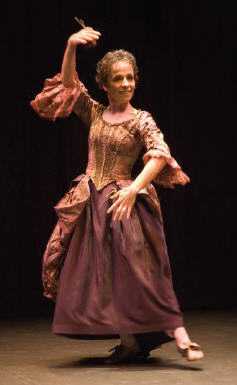- Dance from the Spanish Golden Age: Ana Yepes
- Flamenco dance: Carmen Rubí
- Contemporary dance: Clélia Dufour
Music for dance :
- Music to accompany dance, for instrumentalists or singers, in ensemble or solo: Ignacio Yepes and Gerardo Arriaga
- Tablature lessons, lute, vihuela and baroque guitar, Gerardo Arriaga
- Recorder lessons Ignacio Yepes
Detailed Workshop Program
The dance workshops are meant for dancers, professionals or amateurs, as well as musicians or any interested person.
Spanish Dance of the Golden Age
Initiation to Spanish dance of the Golden Age through learning basic steps, as well as some variations of Españoletas, Paradetas, Jácara, and Folías, according González and Jaque, Spanish dance masters of the seventeenth century.
The work focuses on technique, style, interpretation, and the relation music/dance. Everyone can work on it at their own level, adding arm movements and/or castanets.
Ana Yepes teaches Spanish baroque dance according to Spanish treatises Discursos sobre el Arte del Danzado by Esquivel Navarro (Sevilla 1642), Libro de danzar by Juan Antonio Jaque (seventeenth century), Escuela por lo bajo by Domingo González (seventeenth century) Memoria Danças, by Francesc Olivelles, Barcelona 1701 (book of his student Joseph Potau y Ferrán), Chorégraphie figurativa y demonstrativa del arte de danzar en la forma española de Noveli (Madrid 1708) and Pablo Minguet, Explicación del danzar a la española, Danzas and Danzas a la española, Madrid, 1740.
NB: If you have castanets, please bring them.
Flamenco dance
Working on the "flamenco" Tangos. This is a measure of 4/4. Body percussion exercises with the feet (zapateado) and hands (palmas) will be studied. We will practice variations in order to create a choreography.
Working on the "flamenco" Alegrías. This is a measure of 12/8. The work will be done in three stages: Braceo [arm movements] to the rhythm of Alegrías and some marcajes [pointed steps] with the arms coordination, and llamadas and remates typical of this Flamenco palo, and practice on escobilla (step a bit more advanced for the feet technique, for those interested), as well as several choreographic variations to music.
Contemporary dance
From the fundamentals of contemporary dance (time, space, weight, form, energy) we will evolve towards an articulated gesture language, sometimes with hits (body percussions) and punctuated (with rhythm games), sometimes fluid and spread, and with a direct link to the Spanish music proposed in the Academy.
At these workshops, we will experience the notions of balance and imbalance, rhythm, quality of movement, the work of individual composition (with improvisation as the main tool), as well as the creation of choreographic phrases to Spanish music.
Spanish music of the Golden Age
These workshops are addressed to instrumentalists and singers who wish to work on interpretation of Spanish dances of the Golden Age, solo or in ensemble, with the particular aim on playing for dancing and therefore willing to work on the adjustments of tempi, dynamics, phrasing and articulation that this implies. Work also on memorizing, construction of rhythmic and melodic phrases specific to each dance. Practice in the art diminutions within one or all parts to a dance piece. Practice on improvisation of tañidos (musical variations) on tunes of Pavana, Gallarda, Españoletas, Villano, Paradetas, Jácara, Canarios, Folías and Folies d'Espagne.
Musicians
Specific classes on recorder, modern flute, modern or baroque guitar may be considered depending on the wish of the students. Tablature classes are also available to interested parties.
All ancient and modern instruments are welcome.
For music lessons, the classes’ organization and the schedules will depend of the enrolled people and their choices. For now, and in order to organize it the best possible, please specify your wishes:
Would you participate in a dance workshop? If so, choose it above and then select the music class in the remaining time period and we will do our best to give you satisfaction.
Musicians can bring their own instrument even if there are no classes on this instrument, whether Renaissance, Baroque or modern, to play in the ensembles. Thank you for specifying what instrument you play, or the range of your voice if you are a singer.
The common tuning will be 440.
Additional Information
Location: Departmental Conservatory of the City of Evreux – Normandy - France
12 pair rue Jean-Jaurès - 27000 ÉVREUX – France
Prices: Tuition fees, single tariff of 320 euros (50 hours of training provided over 7 days)
+ 20 euros mandatory membership for the Donaïres Ensemble Association.
Warning: A deposit in the amount of €100 will be requested at time of registration, non-refundable deposit for cancellations received after June 15, 2016.
| Attachment | Size |
|---|---|
| 149.33 KB | |
| 140.55 KB |
